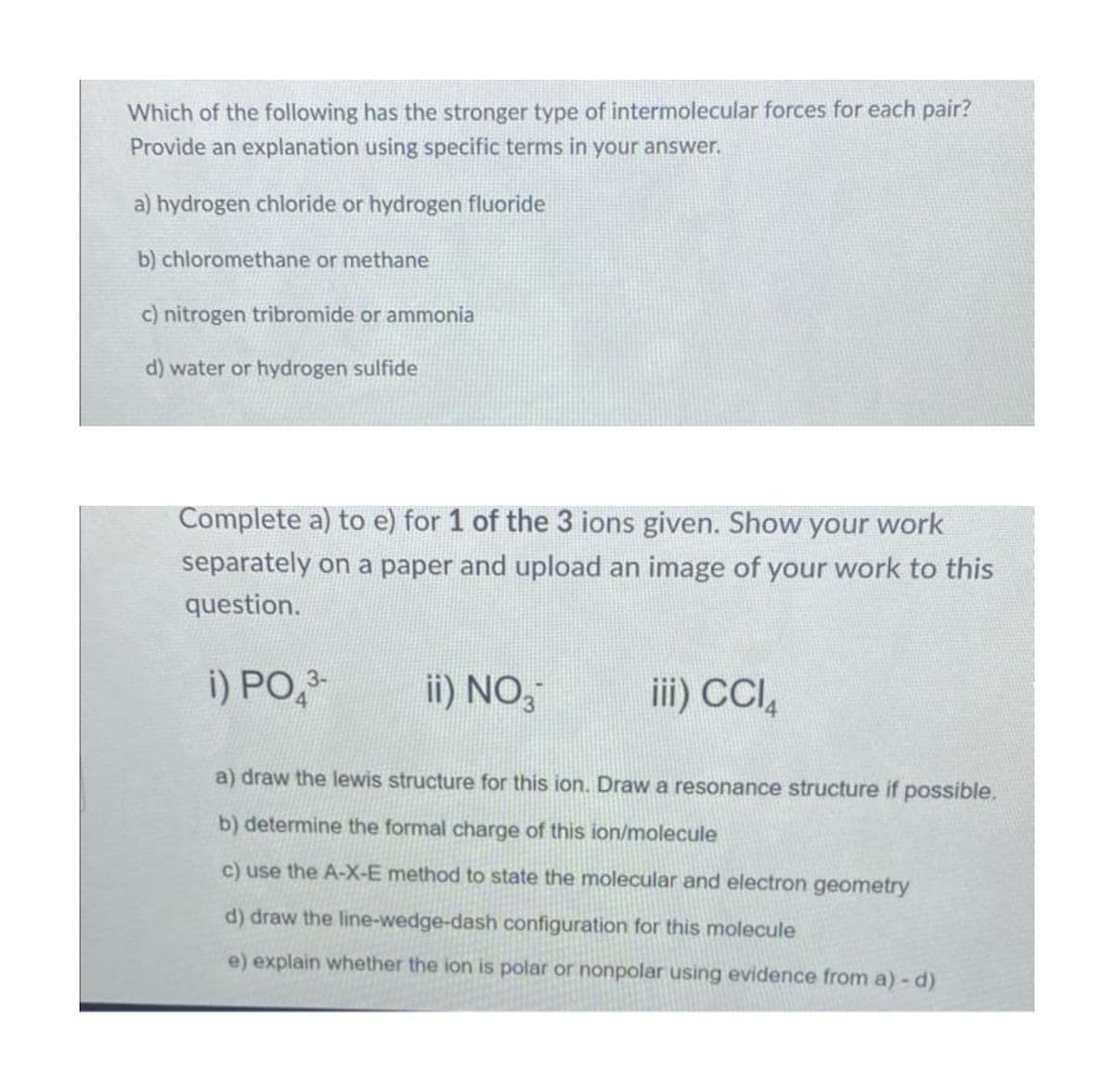Which of the following has the stronger type of intermolecular forces for each pair? Provide an explanation using specific terms in your answer. a) hydrogen chloride or hydrogen fluoride b) chloromethane or methane c) nitrogen tribromide or ammonia d) water or hydrogen sulfide
Which of the following has the stronger type of intermolecular forces for each pair? Provide an explanation using specific terms in your answer. a) hydrogen chloride or hydrogen fluoride b) chloromethane or methane c) nitrogen tribromide or ammonia d) water or hydrogen sulfide
Introductory Chemistry: A Foundation
9th Edition
ISBN:9781337399425
Author:Steven S. Zumdahl, Donald J. DeCoste
Publisher:Steven S. Zumdahl, Donald J. DeCoste
Chapter14: Liquids And Solids
Section: Chapter Questions
Problem 38QAP: Two molecules that contain the same number of each kind of atom but [hat have different molecular...
Related questions
Question
Please answer both questions

Transcribed Image Text:Which of the following has the stronger type of intermolecular forces for each pair?
Provide an explanation using specific terms in your answer.
a) hydrogen chloride or hydrogen fluoride
b) chloromethane or methane
c) nitrogen tribromide or ammonia
d) water or hydrogen sulfide
Complete a) to e) for 1 of the 3 ions given. Show your work
separately on a paper and upload an image of your work to this
question.
i) PO 3-
ii) NO 3
iii) CCl4
a) draw the lewis structure for this ion. Draw a resonance structure if possible.
b) determine the formal charge of this ion/molecule
c) use the A-X-E method to state the molecular and electron geometry
d) draw the line-wedge-dash configuration for this molecule
e) explain whether the ion is polar or nonpolar using evidence from a) - d)
Expert Solution
This question has been solved!
Explore an expertly crafted, step-by-step solution for a thorough understanding of key concepts.
Step by step
Solved in 2 steps with 1 images

Knowledge Booster
Learn more about
Need a deep-dive on the concept behind this application? Look no further. Learn more about this topic, chemistry and related others by exploring similar questions and additional content below.Recommended textbooks for you

Introductory Chemistry: A Foundation
Chemistry
ISBN:
9781337399425
Author:
Steven S. Zumdahl, Donald J. DeCoste
Publisher:
Cengage Learning

Chemistry: Principles and Practice
Chemistry
ISBN:
9780534420123
Author:
Daniel L. Reger, Scott R. Goode, David W. Ball, Edward Mercer
Publisher:
Cengage Learning

World of Chemistry, 3rd edition
Chemistry
ISBN:
9781133109655
Author:
Steven S. Zumdahl, Susan L. Zumdahl, Donald J. DeCoste
Publisher:
Brooks / Cole / Cengage Learning

Introductory Chemistry: A Foundation
Chemistry
ISBN:
9781337399425
Author:
Steven S. Zumdahl, Donald J. DeCoste
Publisher:
Cengage Learning

Chemistry: Principles and Practice
Chemistry
ISBN:
9780534420123
Author:
Daniel L. Reger, Scott R. Goode, David W. Ball, Edward Mercer
Publisher:
Cengage Learning

World of Chemistry, 3rd edition
Chemistry
ISBN:
9781133109655
Author:
Steven S. Zumdahl, Susan L. Zumdahl, Donald J. DeCoste
Publisher:
Brooks / Cole / Cengage Learning

Introductory Chemistry: An Active Learning Approa…
Chemistry
ISBN:
9781305079250
Author:
Mark S. Cracolice, Ed Peters
Publisher:
Cengage Learning

Principles of Modern Chemistry
Chemistry
ISBN:
9781305079113
Author:
David W. Oxtoby, H. Pat Gillis, Laurie J. Butler
Publisher:
Cengage Learning

Chemistry for Engineering Students
Chemistry
ISBN:
9781337398909
Author:
Lawrence S. Brown, Tom Holme
Publisher:
Cengage Learning